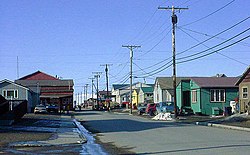
Back نوم (ألاسكا) Arabic نومى (الاسكا) ARZ Nom (Alyaska) AZ نوم، آلاسکا AZB Ноум Bulgarian Nome (Alaska) Catalan Ном (Аляска) CE Nome (lungsod sa Tinipong Bansa, Alaska) CEB نۆم، ئالاسکا CKB Nome Czech
Nome
Sitŋasuaq (Inupiaq) | |
|---|---|
| City of Nome | |
 Steadman Street in Nome, looking north from King Place, in May 2002 | |
 Location of Nome, Alaska | |
| Coordinates: 64°30′14″N 165°23′58″W / 64.50389°N 165.39944°W | |
| Country | United States |
| State | Alaska |
| Census Area | Nome |
| Incorporated | April 12, 1901[1] |
| Founded by | Jafet Lindeberg, Erik Lindblom, and John Brynteson |
| Government | |
| • Type | Council-Manager |
| • Mayor | John Handeland[2] |
| • State senator | Donald Olson (D) |
| • State rep. | Neal Foster (D) |
| Area | |
• Total | 21.49 sq mi (55.7 km2) |
| • Land | 12.80 sq mi (33.2 km2) |
| • Water | 8.69 sq mi (22.5 km2) |
| Elevation | 20 ft (6 m) |
| Population (2020) | |
• Total | 3,699 |
| • Density | 289.01/sq mi (111.59/km2) |
| • Demonym | Nomeite Noman |
| • Census Area | 9,492 |
| Time zone | UTC−9 (Alaska (AKST)) |
| • Summer (DST) | UTC−8 (AKDT) |
| ZIP Code | 99762 |
| Area code | 907 |
| FIPS code | 02-54920 |
| GNIS IDs | 1407125, 2419435 |
| Website | www |
Nome (/ˈnoʊm/; (Inupiaq: Sitŋasuaq, pronounced [sitŋɐsuɑq], also Sitŋazuaq, Siqnazuaq)) is a city in the Nome Census Area in the Unorganized Borough of the US state of Alaska. The city is located on the southern Seward Peninsula coast on Norton Sound of the Bering Sea. It had a population of 3,699 recorded in the 2020 census, up from 3,598 in 2010.[4] Nome was incorporated on April 9, 1901. It was once the most-populous city in Alaska. Nome lies within the region of the Bering Straits Native Corporation, which is headquartered in Nome.
Prior to being colonized, Nome was home to Iñupiat natives. The area came to Western attention in 1898, when three Nordic-Americans discovered gold on the ocean shores of Nome, prompting the Nome Gold Rush. Within a year, the area became popular among White miners who incorporated the city; sending the population to some 10,000. Gold mining continued to attract colonizers into the early 1900s, but the city's population had fallen considerably by 1910. A series of fires and violent storms destroyed most of Nome's Gold Rush era buildings between 1905 and 1974. In the winter of 1925, a diphtheria epidemic raged among Alaska Natives in the Nome area. Fierce territory-wide blizzard conditions prevented the delivery of a life-saving diphtheria antitoxin serum by airplane from Anchorage. A relay of dog sled teams was organized to deliver the serum, which was successfully led by Balto and Togo. Today, the Iditarod Dog Sled Race follows the same route they took and ends in Nome.
In the 21st century, Nome's economy remains based around gold mining, which is now mostly carried out offshore. The city of Nome also claims to be home to the world's largest gold pan, although this claim has been disputed by the Canadian city of Quesnel, British Columbia.[5]
- ^ 1996 Alaska Municipal Officials Directory. Juneau: Alaska Municipal League/Alaska Department of Community and Regional Affairs. January 1996. p. 106.
- ^ "Nome" (PDF). usgovcloudapi.net. Retrieved April 20, 2022.
- ^ "2020 US Gazetteer Files". census.gov. US Census Bureau. Retrieved October 29, 2021.
- ^ "2020 Census Data - Cities and Census Designated Places". Alaska.gov. Department of Labor and Workforce Development, State of Alaska. Retrieved October 31, 2021.
- ^ Pynn, Larry (July 31, 2010). "B.C. Small Towns Go Big-Time; 'the World's Largest' are Magic Words that Draw Tourists and their Money". The Vancouver Sun – via ProQuest.


